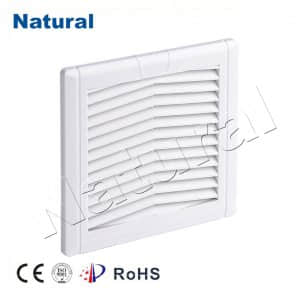Filter fans, though often overlooked, play a vital role in various industries and environments. These unassuming devices are crucial for maintaining optimal conditions in electrical enclosures and ensuring the longevity and reliability of sensitive equipment. In this article, we will delve into the world of filter fans, exploring their functionality, advancements, and diverse applications.

Understanding Filter Fans Filter fans are ventilation devices designed to control the climate inside electrical enclosures, cabinets, and other sealed environments. They consist of a housing, a fan, and a filter element. The primary purpose of a filter fan is to expel hot air and prevent the buildup of heat within these enclosures. They achieve this by drawing in cooler ambient air and pushing out the heated air, thus maintaining a stable temperature and preventing equipment from overheating.
The Anatomy of a Filter Fan
Housing: The housing is typically made of sturdy materials such as plastic or metal. It encloses the fan and filter element, protecting them from external contaminants.
Fan: The fan is the heart of the filter fan. It circulates air within the enclosure, facilitating heat exchange with the surroundings. Filter fans can come in various sizes and airflow capacities, allowing for customization based on specific needs.
Filter Element: The filter element is the component responsible for removing dust, dirt, and other particles from the incoming air. Keeping a clean environment inside the enclosure is essential to prevent damage to sensitive equipment.
Advancements in Filter Fan Technology
Filter fan technology has evolved significantly over the years to meet the increasing demands of modern industries. Some notable advancements include:
Energy Efficiency: Manufacturers have developed filter fans that are more energy-efficient, helping reduce power consumption and operational costs.
Smart Controls: Filter fans equipped with smart controls and sensors can automatically adjust fan speed and airflow based on temperature and humidity levels inside the enclosure.
Longer Filter Lifespan: Improved filter materials and designs have extended filter lifespans, reducing maintenance frequency.
Reduced Noise Levels: Quieter filter fans are available, making them suitable for noise-sensitive environments.
Modular Design: Filter fans with modular components allow for easy installation and replacement, minimizing downtime during maintenance.
Applications of Filter Fans
Filter fans find applications in a wide range of industries and environments:
Industrial Automation: In manufacturing facilities, filter fans help control the climate inside control cabinets, ensuring the reliability of automation equipment.
Telecommunications: They are used to maintain stable conditions for sensitive telecommunications equipment, including servers and routers.
Renewable Energy: Filter fans play a role in renewable energy systems, where they protect electrical components in wind turbines and solar power installations.
Food Processing: In food processing plants, filter fans help regulate the environment inside electrical enclosures to prevent contamination.
Transportation: They are used in railway signaling systems, where reliability is paramount for safety.
Medical Equipment: Filter fans maintain temperature and humidity levels in medical equipment enclosures, preserving the functionality of critical devices.
Conclusion
Filter fans may not always be in the spotlight, but their importance in various industries cannot be overstated. With ongoing advancements in technology, these unassuming devices continue to ensure the optimal functioning and longevity of sensitive equipment in a variety of environments. As industries evolve, so too will filter fan technology, adapting to meet the ever-changing demands of modern technology and manufacturing.
 28 items Patent
28 items Patent
 28 items Patent
28 items Patent
 28 items Patent
28 items Patent

